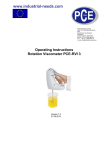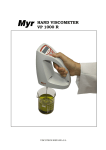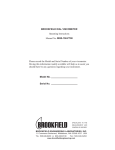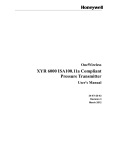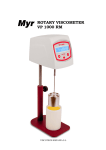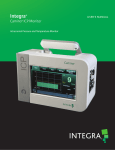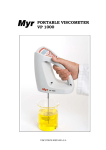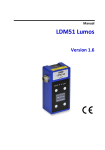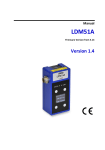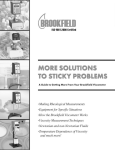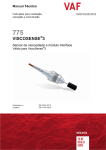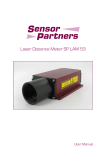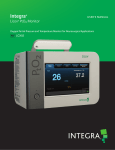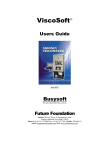Download Rheosys Merlin II User Manual
Transcript
Rheosys Merlin II User Manual Aug 2008 Volume 1, Issue 2 DESIGN & INNOVATION Rheosys Merlin II Table of Contents Merlin II Overview......................................................................... 4 Instrument Setup ...................................................................................................... 6 Main Instrument control panel 9 Main Menu 10 Manual operation 26 Supervisor / Service settings: 29 Merlin II Overview......................................................................... 4 Instrument Setup ...................................................................................................... 6 Main Instrument control panel 9 Main Menu 10 Manual operation 26 Supervisor / Service settings: 29 Rheosys Merlin II User Manual 3 Rheosys Asphalt DRV Merlin II Overview. The Merlin II is a programmable controlled shear rate rheometer / viscometer with integrated temperature control and automated test capabilities. The Merlin II measures fluid parameters of Shear Stress and Viscosity at given Shear Rates. Viscosity is a measure of a fluid’s resistance to flow. The principle of operation of the Merlin II is to drive a spindle (which is immersed in the test fluid) at the set speed with a high degree of accuracy. The viscous drag of the fluid against the spindle is measured by the current required to maintain the rotational speed. The current is measured with a high resolution current sensing transducer. The measuring range of the Merlin II (in centipoise) is determined by the rotational speed of the spindle, the size and shape of the spindle, the container the spindle is rotating in, and the full scale torque range. Torque Dyne•cm 200,000.0 mN•m 20.0 All units of measurement are displayed according to either the CGS system or the SI system. 1. Viscosity appears in units of centipoise (shown as “cP”) or milliPascal-seconds (shown as mPa•s). 2. Shear Stress appears in units of Pascal’s (Pa.). Newtons/square meter (“N/m2”). 3. Shear Rate appears in units of reciprocal seconds (“1/s”). 4. Torque appears in units of micro Newton-meters(“uNm”), also shown as percent “%” of available full scale torque. The equivalent units of measurement in the SI system are calculated using the following conversions: SI CGS Viscosity: 1 mPa•s = 1 cP Shear Stress: 1 Newton/m2 = 10 dyne/cm2 Torque: 1 N•m = 107 dyne•cm WARNING: Use of this instrument in a manner not specified by Rheosys may result in incorrect readings or instrument failure. Please read this manual prior to using the instrument. 4 Asphalt DRV User Manual Rheosys Merlin II Utilities: Autosensing medical power supply pt#100201 Input Voltage: Input Frequency: Power: Power cord 100 – 250 VAC 50 - 60 Hz 60 W IEC320 Environmental: Temperature: 23°C (± 4°C) (73°F (± 6°F)) Humidity: 10 to 80% Specifications: Speed range: 0.1 - 2000 RPM, 0.1RPM Increments. Viscosity Accuracy: ± 1.0% of full scale range for a specific spindle running at a specific speed. Temperature Sensing: 0°C to 100°C (32°F to 212°F) -10.0°C to 120°C (14°F to 248°F) with additional fluid connection at rear. Temperature Accuracy: ± 0.5°C over full range Torque Range: 0 to 20,000 uNm Computer Interface: serial RS232 Data retention: All changes made to configuration settings are stored to flash RAM & recalled at power up. Rheosys Merlin II User Manual 5 Rheosys Asphalt DRV Instrument Setup The Merlin II comes complete with the following: The Merlin II Instrument with PSU The Thermoelectric Cell + Integrated stand with PSU RS232 serial cable, I2C serial cable locking nut & pin, User Manual 25mm coaxial cylinder set 30mm Parallel plate set 5.4 degree 30mm cone or 2 degree 30mm cone Windows research software “micra” Setup. Place the integrated thermoelectric temperature controller & instrument stand on a flat level surface. Insert the viscometer into the main mounting bracket. 6 Asphalt DRV User Manual Rheosys Merlin II The viscometer is secured to the stand using the two Allen grub screws on either side of the of the main bracket. The main bracket & viscometer are raised and lowered by turning the knob on the right hand side. To the rear of the knob located on the main collar is a 3/16 brake nut, this can be adjusted using an 3/16 Allen key to increase or decrease the resistance when raising the viscometer. Using a spirit level, level the instrument by adjusting the leveling feet on the base. Rheosys Merlin II User Manual 7 Rheosys Asphalt DRV Once the power and communications cables have been connected, the power on sequence is as follows: Power up sequence 1. Switch on the temperature controller. The power switch is located on the right rear side of the unit. ** wait 10 seconds for the controller to initialize. The LED will illuminate once initialization is complete. 2. Switch on the instrument. The power switch is located on the right rear of the unit. The following sequence should be observed: The Viscometer display should show the initialization screen showing model & serial number. Rheosys recommends that you allow 10 minutes for the instrument to warm up prior to making measurements. 8 Asphalt DRV User Manual Rheosys Merlin II When the instrument has initialized it will attempt to communicate with the temperature controller. If successful the display will show the new set point value (this is the last set / stored temperature). If the connection was unsuccessful, the message "Temp Control Option not detected" will be displayed. Check the cables and re-try power up sequence. Main Instrument control panel The membrane keypad control panel is used to access the instrument functions. Menu. Access the instrument settings, see menu for more information Enter. Confirms current selection & saves changes Esc. Exit current selection without saving changes. Also sets rotational speed to zero. Speed. Selects the manual speed menu Up key. Moves selection or value up Down key. Moves selection or value down Number keys. Used to enter numerical values Rheosys Merlin II User Manual 9 Rheosys Asphalt DRV Main Menu The menu key accesses the menu options. To access a menu option press the numerical key that corresponds to the menu option. Any changes made to the menu options are stored in flash RAM and become the default value recalled at power up. To exit the main menu press ESC. 10 Asphalt DRV User Manual Rheosys Merlin II 1. General Options The Options area contains many instrument and communications settings. Press 1 To access the settings from the main menu. Each option will be displayed in turn. Pressing ENTER confirms & stores the selection of the current value (changed or not) & moves the display on to the next option Pressing ESC moves to the next option without storing any change. Set Increment: default value = 20.0 The Increment value provides a quick method of stepping up or down a pre-defined speed increment (RPM) To change the current value use the numerical keys, press enter when done or escape to ignore changes When the instrument is in the main display mode, the rotational speed can be incremented or decremented by this value by pressing the up or down key. example: if the increment value = 20.0 After power up, while the main screen is displayed, the speed can be changed from zero to 20.0 PRM by pressing the up key once. If the up key is pressed again the speed will increase to 40.0, if the down key is pressed the speed will decrease to 20.0. Rheosys Merlin II User Manual 11 Rheosys Asphalt DRV Integration Width: default = 10 seconds The raw torque can be averaged over several cycles to improve the stability of the signal. The trade off is that the sampling time at each speed has to be increased to a minimum of the integration width. To change the value use the up/dn keys, press enter when done or escape to ignore changes 12 Asphalt DRV User Manual Rheosys Merlin II 2. Display The display can be changed from the standard display layout to the scientific display layout. Rheosys Merlin II User Manual 13 Rheosys Asphalt DRV 3. Temperature Offset The temperature offset allows the user to do a single point temperature calibration. When the offset value is changed and the [ENTER] key is pressed. The change is stored in the flash RAM. The offset can be adjusted using the up/dn arrow keys. The range is –10.0 to +10.0C The default value is 0 Whenever a change is made to the offset the set point is re-sent to the temperature controller. 4. Program The instrument has the capability of receiving and storing tests defined in the Rheosys Windows software. These stored tests can then be run away from the controlling PC. The results are stored to flash RAM & can be uploaded to the PC at a later time for analysis & permanent storage to disk. for more details on defining test see the help section of the "micra" software. Tests that have been downloaded to the instrument from the PC can be run or edited from the "program" section of the options menu. 14 Asphalt DRV User Manual Rheosys Merlin II • Press 4 to enter the program section. Display will show the program control menu. The status of the 20 available program memory locations can be viewed from here by pressing the up/dn key to move up or down thru the list. The following information will be displayed for each test: • To quit without running or editing a test press ESC. • To Edit the program location press 0. In the edit menu you can remove stored test parameters & data. Rheosys Merlin II User Manual 15 Rheosys Asphalt DRV • To run the stored test click ENTER. NOTE: attempting to run an empty location can result in loss of communication. Switch unit OFF and then back ON. The display will change to the "run test" screen. The test follows the following format: 1. Set 1st speed (RPM) 2. Countdown the programed delay time 3. Countdown the programed Integration time + aquire data 4. Store final values for programed speed. 5. Set next speed - loop repeat from 2. The following information will be displayed during the test run: 16 Asphalt DRV User Manual Rheosys Merlin II 5. Set T ( Set a new Temperature ). This option allows the user to change the temperature set point of the connected temperature controller. The value can be changed using the UP/DOWN arrow keys. Once the value has been changed the [ENTER] key will save the set point and send the change to the temperature controller. The [ESC] key can be used to quit the menu option without saving or setting the temperature. The set point resolution is 1°C When the user presses the [ENTER] key the set point is stored in flash ram then sent to the temperature controller. 6. MeaSys The Measuring System selection option. Users can change the selected measuring system to match the spindle or measuring system attached to the instrument. Each available system has its own display showing the title and constants C1 & C2. To view the available systems press the up or down arrows. To select the currently displayed system press ENTER Rheosys Merlin II User Manual 17 Rheosys Asphalt DRV example: System 2 selected = C25 (25mm Concentric cylinders) Default measuring systems. System Title C1 C2 1 C14 * 140609 10.452 2 C25 * 24694 10.452 3 C14 Infinite Sea ** 154700 1.996 4 C25 Infinite Sea ** 27160 1.996 5 24/27 Double Gap * 9535 10.452 6 CP 2.5/30, 70um Gap 141471 22.918 7 CP 5.4/30, 150um Gap 141471 10.610 8 PP 15, 0.5mm Gap 1131768 11.250 9 PP 15, 1mm Gap 1131768 5.625 10 PP 15, 2mm Gap 1131768 2.812 11 PP 30, 0.5mm Gap 141471 22.50 12 PP 30, 1mm Gap 141471 11.25 13 PP 30, 2mm Gap 141471 5.625 14 C 25 vane rotor * 24640 10.452 18 Asphalt DRV User Manual Rheosys Merlin II 15 S21 16.75mm Spindle *** 64400 8.887 16 S27 11.75mm Spindle *** 117100 3.231 Setting the correct gap. The Merlin II has an adjustable micro collar attached to the stand column at the rear of the temperature controller. This can be raised and lowered to set the correct gap for the measuring system in use. Gap notes: * The correct gap for this system is set when the parallel plate system is inserted and the gap is zero. The desired measuring system can then be inserted. ** No set gap. Bob should be fully immersed in sample *** System not used on Merlin type instrument Measuring Systems Measuring systems fall into three basic categories. These are ; (1) Cone and Plate (2) Parallel Plates (3) Cup and bob Each type has its associated advantages and disadvantages which will be described in the following sections. Rheosys Merlin II User Manual 19 Rheosys Asphalt DRV Cone and plate This is in many instances the ideal measuring system. It is very easy to clean, requires relatively small sample volumes and with a little care can be used on materials having a viscosity down to about ten times that of water (10 mPa.S). Figure-6 Cone and plate measuring systems are usually referred to by the diameter and the cone angle. For instance a CP5.4/30 is a 30mm diameter cone having an angle of 5.4° Often cones are truncated. These types of cone are positioned such that the theoretical (missing) tip would touch the lower plate. By removing the tip of the cone, a more robust measuring system is produced. This can be seen in figure-6 Cone angles Since strain and shear rate are calculated using the angular displacement and the gap it follows that the smaller the cone angle, the greater the error is likely to be in gap setting and hence your results. By using a relatively large angle (4° or 5°) it becomes easier to get reproducibility of gap setting. Although the larger the cone angle the more the shear rate across the gap starts to vary. In considering what cone angle to use it is worth looking at variations of shear against the gap compared to reproducibility of gap setting. The following table of expected errors comes from work by Adams and Lodge. 20 Asphalt DRV User Manual Rheosys Merlin II CONE ANGLE VARIATION OF SHEAR TYPICAL ERROR IN (O) RATE ACROSS GAP % CALCULATIONS % 1 2 3 4 5 7 10 0.03 0.21 0.28 0.49 0.77 1.5 3.1 0.02 0.08 0.18 0.32 0.50 0.98 2.0 This shows that for a 4° cone the shear rate will vary by less than 0.5% across the gap giving data with around 0.3% error. If a smaller cone angle is used, although the shear distribution error is small, the operator to operator gap settings could easily introduce errors of over 5% even by experienced operators and so the larger angle gives a more acceptable error since it is a reproducible error. When not to use a cone and plate. Because of the importance of correct positioning (often referred to as 'gap setting') a cone and plate is not recommended when performing temperature sweeps. If you must use a cone, use the largest cone angle and diameter available to you to minimize the errors and try to set the gap at approximately the mid-range temperature of your sweep. You should also avoid using a cone if the sample you are testing contains particulate material. If the mean particle diameter is not some five to ten times smaller than the gap, the particles can 'jam' at the cone apex resulting in noisy data. Materials with a high concentration of solids are also prone to being expelled from the gap under high shear rates, another reason to avoid the use of the cone. Parallel plate The parallel plate (or plate-plate) system, like the cone and plate, is easy to clean and requires a small sample volume. It also has the advantage of being able to take pre-formed sample discs which can be especially useful when working with polymers. It is not as Rheosys Merlin II User Manual 21 Rheosys Asphalt DRV sensitive to gap setting, since it is used with a separation between the plates measured in mm. (See Figure-7) Because of this it is ideally suited for testing samples through temperature gradients. Figure-7 Advantages and disadvantages of parallel plates The main disadvantage of parallel plates comes from the fact that the shear rate produced varies across the sample. Note also that the wider the gap, the more chance there is of forming a temperature gradient across the sample and so it is important to surround the measuring system and sample with a thermal cover. Parallel plate systems are referred to by the diameter of the upper plate. For instance, a PP30 is a 30mm diameter plate. The lower plate is either larger than or the same size as the upper plate. When it is important to test samples at a known shear rate for critical comparisons the use of Parallel plates is not recommended. Sample loading for cone and plate and parallel plate measuring systems. The sample should just fill the gap between the upper and lower elements. If the sample is likely to shrink during the test (due to solvent loss etc.) it is advisable to aim for a slight bulge or taper as shown in Figure-8. If too much or too little sample is used, the torque 22 Asphalt DRV User Manual Rheosys Merlin II produced will be incorrect leading to the data being higher or lower respectively. Figure-8 Preventing solvent loss / drying Some samples may be prone to skinning or drying. This will happen at the edge of the sample to its exposure to atmosphere. To overcome this fit a solvent trap to the measuring system. Another technique is to apply a fine layer of low viscosity (approximately 10 times thinner than the sample) silicon oil around the measuring systems. This works well provided that the oil and sample are not miscible and also that relatively small rotational speeds are being used so as not to mix the oil into the sample. Rheosys Merlin II User Manual 23 Rheosys Asphalt DRV Cup and Bob. Cup and bob type measuring systems come in various forms such as coaxial cylinder, double gap, Mooney cell etc. as shown in figure9. Figure-9 For DIN standard coaxial cylinders they are referred to by the diameter of the inner bob. i.e. a C25 is a coaxial cup and bob having a 25mm diameter bob. The diameter of the cup is in proportion to the bob size as defined by the Standard DIN 530 19. For double gap measuring systems they are usually referred to by the inner and outer diameters i.e. DG 20/30. Advantages / disadvantages of cup and bobs Cup and bob measuring systems require relatively large sample volumes and are more difficult to clean. Their advantage comes from being able to work with low viscosity materials and mobile suspensions. Their large surface area gives them a greater sensitivity and so they will produce good data at low shear rates and viscosities. The double gap measuring system has the largest surface area and is therefore ideal for low viscosity / low shear rate tests. 24 Asphalt DRV User Manual Rheosys Merlin II Preventing solvent loss / drying Some test materials may be prone to 'skinning' with time due to sample evaporation etc. To overcome this fit a solvent trap onto the measuring system. Another technique is to float a very low viscosity (10 to 100 times thinner viscosity) silicon oil on the top of the sample in the cup. This works well provided that the oil and sample are not miscible and also that relatively small rotational speeds are being used so as not to mix the oil into the sample. Rules of thumb for shear rate / shear stress selection. Decrease cone/plate diameter to increase available shear stress. Decrease bob surface area to increase shear stress Decrease cone angle (or gap in a parallel plate) to increase available shear rate ( Remember: smaller the angle the more difficult to set the gap correctly) Use large surface areas for low viscosity and small surface areas for high viscosities. Summary of measuring system selection. Thick materials can be tested with a cone and plate unless they contain particulate matter, in which case use a parallel plate. If you are performing a temperature sweep, use a parallel plate or cup & bob in preference to a cone and plate due to variations in the gap with thermal expansion of the measuring system. For low viscosity materials and mobile suspensions use a cup and bob type system. Maximum sensitivity is obtained with a double concentric cylinder (double gap). For testing low viscosity materials when only small sample volumes are available, use a Mooney Cell (such as a 'small sample cell') Rheosys Merlin II User Manual 25 Rheosys Asphalt DRV Manual operation The instrument can be used as a stand alone manual viscometer for quick single point or multiple point measurements. Prior to making measurements, the following preparations should be followed: Thermoelectric Cell: The thermoelectric Cell controller should be switched on & communicating with the Merlin II, showing correct set point & measured temperature. The temperature should be allowed to stabilize (30 mins) prior to taking measurements. Sample: An accurate volume of the sample to be measured must be in a sample chamber. The sample chamber should be installed into the thermal cell with the selected spindle lowered into the sample to the correct gap (where the main bracket meets the shaft collar). The sample should be allowed to come to temperature prior to taking measurements (30 mins). Selecting a spindle / speed: The process of selecting a spindle & speed for an unknown sample, is normally trial & error. It should be remembered that the viscosity range is inversely proportional to spindle size & the rotational speed. In taking viscosity measurements with the Merlin II there are considerations which pertain to the low viscosity limit of effective measurement. Viscosity measurements should be accepted within the equivalent % Torque Range from 5 to 100% for any spindle/speed combination. This consideration has to do with the precision of the instrument. All Merlin II instruments have a full scale range precision of (+/-) 1% of any spindle/speed combination. * (This is an industry standard range common to instruments such as the Brookfield DVII / DVIII & Bohlin V2000) We discourage taking readings below 2% of range because the potential viscosity error of (+/-) 1% is a relatively high number compared to the instrument reading. Once the instrument initialization is complete and the display shows either the scientific (SI) or standard (CGS) screen, the following functions are available from the main control panel keypad. 26 Asphalt DRV User Manual Rheosys Merlin II Manual speed control menu Pressing the speed key will access the manual speed control menu. This menu is used to set a manual speed. Range 0.1 RPM to 2000 RPM. Enter the required speed using the numerical keys. Press ENTER to set new speed or ESC to quit menu without changing current speed. The current speed can be set to zero at anytime by pressing the ESC key from the instrument panel. Rheosys Merlin II User Manual 27 Rheosys Asphalt DRV The speed can be increased or decreased by the incremental value set in (Menu / 1. Options / *Set increment*) by using the up/dn keys. As with any instrument, there are variables that can affect a viscosity measurement. These variables may be related to the instrument (Rheometer) or the test fluid. Variables related to the test fluid deal with the rheological properties of the fluid, while instrument variables would include the Rheometer design and the spindle geometry system utilized. RHEOLOGICAL PROPERTIES Fluids have different rheological characteristics that can be described by Rheometer measurements. We can then work with these fluids to suit our lab or process conditions. There are two categories of fluids: Newtonian - These fluids have the same viscosity at different Shear Rates (different RPM’s) and are called Newtonian over the Shear Rate range they are measured. Non-Newtonian - These fluids have different viscosities at different shear rates (different RPM’s). They fall into two groups: 1) Time Independent non-Newtonian 2) Time Dependent non-Newtonian The time dependency is the time they are held at a given Shear Rate (RPM). They are non-Newtonian, and when you change the Rheometer spindle speed, you get a different viscosity. Time Independent Pseudoplastic - A pseudoplastic material displays a decrease in viscosity with an increase in shear rate, and is also known as “shear thinning”. If you take Rheometer readings from a low to a high RPM and then back to the low RPM, and the readings fall upon themselves, the material is time independent pseudoplastic and shear thinning. Time Dependent 28 Asphalt DRV User Manual Rheosys Merlin II Thixotropic - A thixotropic material has decreasing viscosity under constant shear rate. If you set a Rheometer at a constant speed, recording viscosity (cP) values over time and find that the viscosity (cP) values decrease with time, the material is thixotropic. Rheometer Related Variables Most fluid viscosities are found to be non-Newtonian. They are Shear Rate dependent on the measurement conditions. The specifications of the Rheometer spindle and chamber geometry will affect the viscosity readings. If one reading is taken at 25 rpm, and a second at 50 rpm, the two viscosity (cP) values produced will be different because the readings were made at different shear rates. The faster the spindle speed, the higher the shear rate. The shear rate of a given measurement is determined by: the rotational speed of the spindle, the size and shape of the spindle, the size and shape of the container used, and therefore, the distance between the container wall and the spindle surface. A repeatable viscosity test should control or specify the following: 1) Test temperature 2) Sample container size (or spindle/chamber geometry) 3) Sample volume 4) Rheometer model 5) Spindle used 6) Test speed or speeds (or the shear rate) 7)Length of time or number of spindle revolutions to record viscosity. Supervisor / Service settings: To access the supervisor service menu, follow these steps. From the main screen press the menu key. The screen will change to show the main options menu. Press menu key again & release. after approx. 3 seconds the screen will go blank. Rheosys Merlin II User Manual 29 Rheosys Asphalt DRV Press and hold the menu key. after 2 sec the screen will change to the service menu and the instrument will beep. Release the menu key. AutoZero This option performs an automated auto zero function. Over time the residual friction of the motor changes and this can have a small effect on the calculated torque. It is recommended that an auto zero be performed on a regular basis (for example: every 50 hours of operation). Prior to selecting the auto zero option. Make sure the instrument has no spindle connected and that the instrument has been switched on for at least 20 mins. Process: The instrument will rotate the motor at a low to medium speed and measure the motor friction & compare the values to the stored values. After sampling, the instrument will calculate any required changes and the screen will display the calculated values & the message "Auto zero Complete". 30 Asphalt DRV User Manual Rheosys Merlin II If there is a problem with the motor, the screen will display a service message. TRQcal . Torque Calibration This screen allows the user access to the torque parameters of the instrument. Adjustments should not be without cause & instruction from your Rheosys technical representative. For more information contact [email protected] Clock. The instrument has a built in battery backed clock / calendar. The clock/calendar is used to record the time & date of results and calibration data. The clock time & date is programmed during manufacture. The time zone can be changed by changing the hours. The down arrow key is used to cycle through the 24 hour positions until the required hour is set. Rheosys Merlin II User Manual 31 Rheosys Asphalt DRV Fault Diagnosis and Troubleshooting Listed are some of the more common problems that you may encounter while using your rheometer / viscometer. ❏ Spindle Does Not Rotate _ Make sure the motor spins freely when switched off. _ Make sure the rheometer is plugged in & switched on. _ Make sure the desired rpm is displayed. ❏ Perform a motor Check This check verifies the mechanical condition of the shaft and motor assembly in the rheometer. Auto zero the instrument according to directions in the manual. ❏ Inaccurate Readings _ Verify spindle, speed and torque range selection. _ If % readings are under-range (less than 10%), change spindle and/or speed. _ “HI” on the digital display means the unit is over-range (greater than 100%); reduce speed and/or change spindle. _ Verify test parameters: temperature, container, volume, _ Perform a calibration check. Use procedure below. _ Verify tolerances are calculated correctly. If the unit is found to be out of tolerance, the unit may be in need of service. ❏ Display Reading Will Not Stabilize _ Special characteristic of sample fluid. There is no problem with the rheometer. _ Check for erratic spindle rotation _ Bent spindle or spindle coupling. _ Temperature fluctuation in sample fluid ❏ Cannot Read or Change Temperature _ Be sure the Thermal Cell PSU is switched ON. _ Be sure the communications cable from the instrument to the Thermal Cell is connected and secure. _ Switch OFF thermal Cell PSU, wait 20 seconds. Switch Thermal Cell PSU ON. The control LED should illuminate after approx 10sec. _ Switch OFF instrument wait 10 sec. Switch ON. ❏ Cannot Print AASHTO test results _ Be sure the printer is switched ON _ Be sure the option Menu/Options/Autoprint = ON _ Be sure the option Menu/Options/rs232 SERIAL PORT = DTE Printer 32 Asphalt DRV User Manual Rheosys Merlin II ❏ Rheometer Will Not Communicate with PC _ Contact Rheosys or an authorized dealer with the following information: • When the communication error occurs • The exact text displayed when the error occurs • Computer hardware details including processor speed, RAM, network cards, modems, etc. • Computer operating system • Total number of COM ports • List of Rheosys equipment attached to COM ports and their corresponding COM port number Rheosys Merlin II User Manual 33 Rheosys Asphalt DRV Calibration Procedure for Merlin II + Thermoelectric Cell A two-step process is recommended for the Merlin II + Thermoelectric Cell NOTE: Environmental temperature has an effect on the calibration. The instrument should be at room temperature 73°F ± 4°F for several hours prior to calibration. 1) Put the correct volume of viscosity standard fluid (e.g. Cannon Std 1.064 Pa.s (25C) into the sample chamber. The amount varies with the spindle used. Place the sample chamber into the Thermo Cell Container Allow 30 minutes for the temperature to stabilize fully. Using an NIST traceable thermometer, measure the temperature of the viscosity standard, if necessary adjust using the temperature offset option in the main menu, Menu / 3.Offset. wait until changes have taken effect before moving to next step. 2) Evaluate the Merlin II + Thermoelectric Cell according to the procedure listed below: Attach spindle to the Merlin II. Lower the spindle into the sample to the correct depth (until the stage meets the shaft collar). Allow 30 minutes for the viscosity standard, sample chamber and spindle to reach the test temperature. Set a manual speed e.g. 50 RPM. Ensure that the measured torque is above 10%. Measure the viscosity and record the Rheometer readings. Note: The spindle must rotate for at least sixty (60) seconds before a viscosity reading is taken. Interpretation of Calibration Test Results: When verifying the calibration of the Merlin II, the instrument and viscosity standard fluid error must be combined to calculate the total allowable error. The Merlin II is accurate to (+/-) 1% of any full scale spindle/speed viscosity range. Most Viscosity Standards Fluids are accurate to (+/-) 1% of their stated value. (check details of your std fluid) 34 Asphalt DRV User Manual Rheosys Merlin II Example: Calculate the acceptable range of viscosity using a Merlin II with: Torque = 20.0 mNm) C25 Spindle at 50 RPM Standard viscosity of 1064 mPa.s at 25°C: 1) Calculate full scale viscosity range using the equation: Where: Max torque (mNm) = 20 C1 constant = 24694 C2 constant = 10.452 Full Scale Range = 9024 cp The viscosity is accurate to (+/-) 90.2 cP (which is 1% of 9024) 2) The viscosity standard fluid is 1064 cP. Its accuracy is (+/-)1% of 1064cP or (+/-)10.6 cP. 3) Total allowable error is (10.6 + 90.2) cP = (+/-) 101 cP. 4) Therefore, any viscosity reading between 963 and 1165 cP indicates that the Rheometer is operating correctly. Any reading outside these limits may indicate the need to adjust the torque offset constant. Adjust torque offset constant (Moffset). Select the hidden display option by pressing the menu key, then the # 2 key to select Display, then press # 8 key. This will change the display so that the torque offset constant (Moffset) value can be changed while observing the effect on the apparent viscosity. Rheosys Merlin II User Manual 35 Rheosys Asphalt DRV To increase the torque offset constant (and reduce the apparent viscosity) press the # 2 key. To decrease the torque offset constant (and increase the apparent viscosity) press the # 1 key Once the known calibrated viscosity std value has been achieved and the results are within the 1% full scale range press the menu / Display / key # 2, to reset the display to CGS. This will store the new calibration constants & return the instrument to normal operation. If it is not possible to adjust the torque constant or the instrument is still not accurate to (+/-) 1% of any full scale spindle/speed viscosity range after adjustment. There may be an instrument problem. Contact the Rheosys technical support department to determine the nature of the problem. 36 Asphalt DRV User Manual Rheosys Merlin II Conversion Table: Centigrade to Fahrenheit Center Columns (*) are the reference temperature. °C converts to °F on the right of the reference temperature; °F converts to °C on the left of the reference temperature. Rheosys Merlin II User Manual 37 Rheosys Asphalt DRV Warranty Rheosys Thermal Cell Accessories are guaranteed for one year from date of purchase against defects in materials and workmanship. All instruments requiring warranty repair must be returned to Rheosys LLC. or the Rheosys dealer from whom it was purchased for no charge warranty service. Transportation is at the purchaser’s expense. For repair or service in the United States return to: Rheosys LLC. 11 Schalks Crossing Suite 626 Plainsboro, NJ 08536 U.S.A. Telephone: (210) 568-9300 FAX: (210) 568-7454 email: [email protected] 38 Asphalt DRV User Manual






































